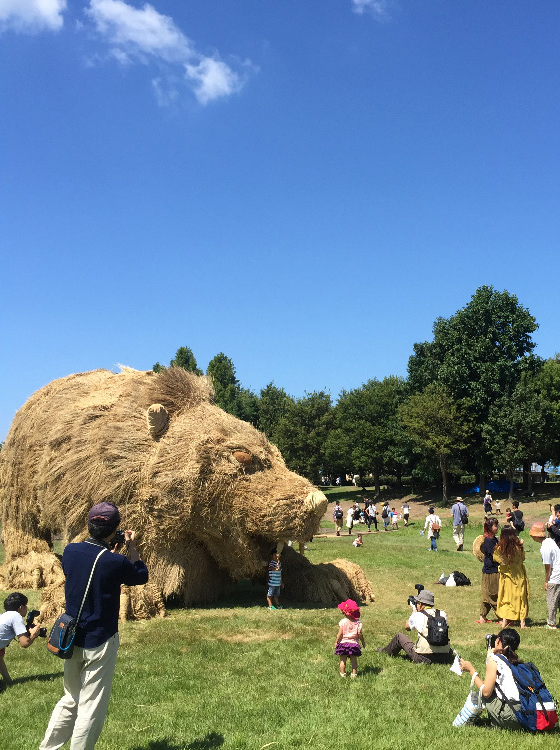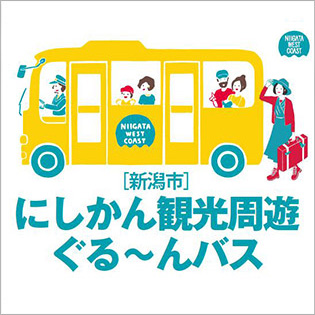About Wara Art
In Niigata, one of Japan's top locations for rice, rice straw is created as a byproduct of rice production. In the past, rice straw was used to make traditional tools utilized in Japanese daily life. However, that form of use is now dying out. As a new way of using rice straw, in 2006 Niigata City and Musashino Art University (known as "Musabi" in Japan) collaborated to create "Wara Art," massive artwork made of rice straw. In 2008, the Wara Art Festival began as an event to exhibit Wara Art.
Rice straw is a symbol of the rice that supports the lives of Japanese people. Through collaboration between Musabi students and Niigata City residents to create artwork made with rice straw and exhibit this as an event, modern usage of rice straw is presented and regional revitalization and people-to-people exchanges are promoted.
The secret of Wara Art
A cooperative project of collaboration between Tokyo art students and farmers from Nishikan Ward


The most unique aspect of Wara Art is the collaboration between
urban young people and the agricultural community of Nishikan
Ward. Wara Art was born amidst exchange between the people of the
former Iwamuro Village (now Nishikan Ward) and Musabi in Tokyo.
Creation and exhibition of Wara Art began in 2006. The idea of
undertaking regional revitalization by creating artwork made with
rice straw, symbolizing the rice-producing Nishikan Ward, was
suggested by Shingo Miyajima, a professor at Musabi at the time.
In the over 10 years that have passed since then, and Musabi
students have been successively creating the artworks. At first,
they were unaccustomed to rice straw and struggled with handling
it. For this, the cooperation of local craftspeople and farmers
was indispensable. There was thus a fusion of youthful artistic
sensibilities and traditional techniques.
Every year, students are invited to form Wara Art creation teams
at Musabi. The students brainstorm motifs and designs for the
artwork, and Nishikan Ward craftspeople construct the artwork
frames based on that. In addition, Nishikan Ward farmers harvest
the rice straw needed for the art and give it to the students.
While the students create the artwork, they stay in Nishikan Ward
and receive advice from the craftspeople and farmers. They eat
local cuisine prepared by the farmers. In this way, the artwork is
completed while the students deepen their exchange with the
locals.
This exchange continues after the artwork is completed and the
students return to Tokyo. The farmers who support the students
receive picture postcards each year. There are also students who
visit Nishikan Ward from Tokyo after graduating. Powerful Wara Art
was born precisely because of the involvement of diverse people
with different ages and perspectives.
Artwork with local roots made using rice straw, a traditional resource from Nishikan


Rice straw, the main material used for making Wara Art, has had a
familiar presence in Japanese daily life since ancient times. It
has been composted after being tilled from the earth for use as
fodder for livestock such as horses and cows, and also used as a
material for items used in daily life such as Japanese traditional
decorations and zori sandals. In winter in the past, when farmers
were unable to do farm work when it snowed, they earned their
living by processing and creating crafts from rice straw as a
substitute for their principal occupation. However, due to
lifestyle changes and the modernization of agriculture, this
culture has gradually faded and there are now few people who
possess those straw art processing techniques.
Toba-Ami, which is used for processing rice straw for use in Wara
Art, is one of the traditional techniques being lost. Rice straw
cannot be used to make art in its natural loose state. For this,
Nishikan Ward farmers conduct weaving work in a sheet shape
(Toba-Ami). There are very few people remaining who possess the
Toba weaving technique, which was once used throughout Japan. It
is precisely because Nishikan Ward is a rice-producing area that
this precious technique lives on.
Toba-Ami is plain yet delicate work. Although each piece of rice
straw is thin and unwieldy, through weaving with strong patience
and the designs by Musabi students, it is transformed into lively
artwork that almost seems alive.

Wara Art Festival Gallery
Shows past artworks, event posters, artwork-making locations,
and more.











